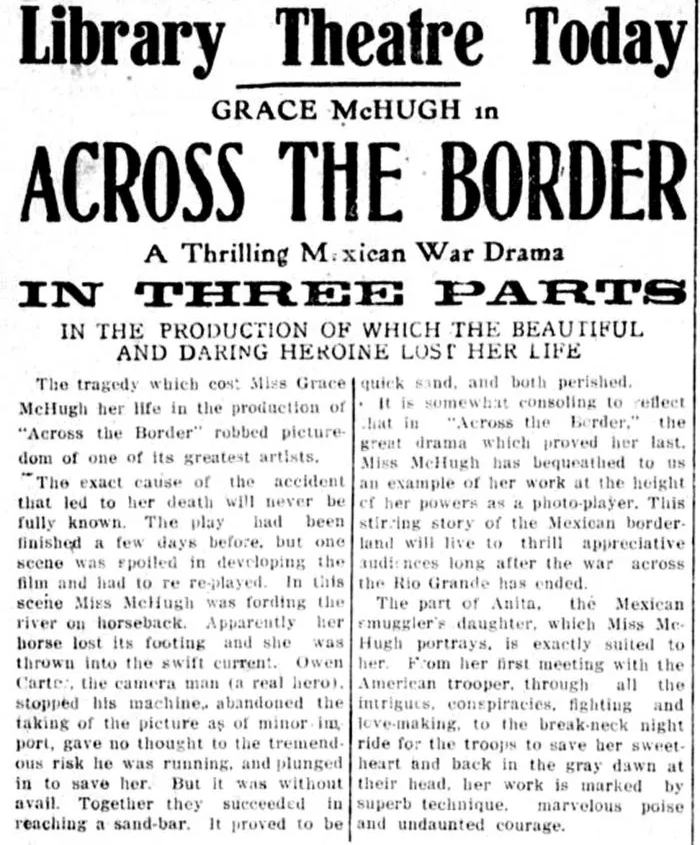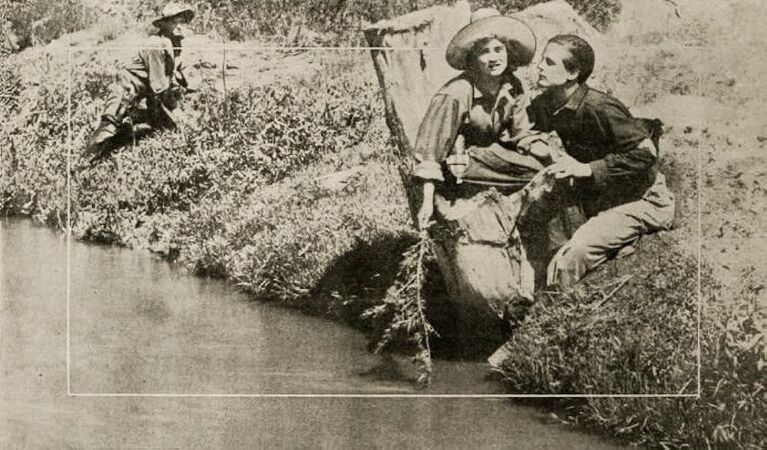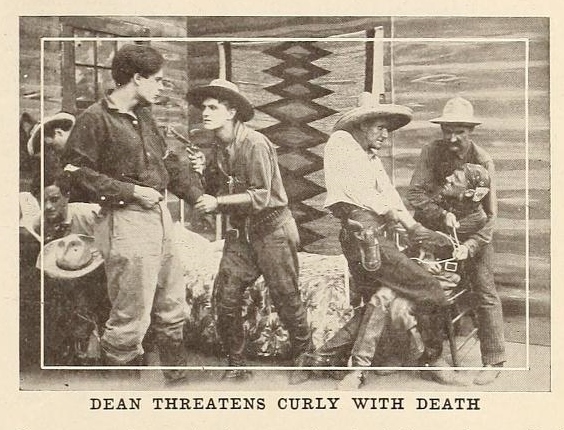Across the Border (lost silent western film and footage of fatal filming accident; 1914)
Advertisement for the film centred around Grace McHugh and Owen Carter's fatal accident during production.
Status: Lost
Across the Border is a 1914 silent Mexican Revolution western film produced by the Colorado Motion Picture Company. Directed by Otis B. Thayer, it starred Edmund Cobb as Curley Smith, a Texas Rangers lieutenant who encounters a gun smuggling operation across the US-Mexican border and sets out to stop the rebellion from subsequently receiving powerful American weaponry and ammunition. However, the film is most infamous for a fatal filming accident which claimed the lives of lead actress Grace McHugh and cameraman Owen Carter.
Background
Across the Border was filmed in Cañon City, Colorado, when the city garnered a growing reputation for western film productions.[1][2][3] A year prior, Otis B. Thayer had established the Colorado Motion Picture Company and harnessed Cañon City as its base of operations, taking advantage of his former employer Selig Polyscope Company's decision to move to California.[1][2][3] This prompted local backing of $5,000, worth over $150,000 in today's money.[3] However, Thayer was under pressure to deliver results on a triweekly basis, as mandated by a three-reel feature film contract he signed with the Warner Feature Company (Warner Bros.).[2][1][3] He therefore fulfilled a dual director/producer role, filming the western films Pirates of the Plains and The Range War in early 1914.[2][1][3]
Across the Border was mostly filmed in June 1914, and its premise was based on current events, namely the Mexican Revolution.[2] This Revolution, initially conducted to overthrow President Porfirio Díaz's dictatorship, saw Mexico plunged into a bloody civil war that lasted throughout almost all of the 1910s, which eventually ended with the country transformed into a republic.[4] The United States, which originally indirectly supported the Mexican Government and even Victoriano Huerta's coup d'état of President Francisco Madero under William Taft's administration, would soon switch allegiance to the Revolution shortly after Woodrow Wilson came to power.[5][6][4] With the exception of its occupation of Veracruz from April to November 1914, the US primarily provided indirect support for the war effort.[7][6][4] However, it also had to contend with constant gunrunning at the US-Mexico border that helped fuel the Revolution's arms supply.[8] The film was based around this aspect of the war.[9][10][11][12][2]
Edmund Cobb was selected to portray Curley Smith, a Texas Rangers lieutenant and the film's main protagonist.[13][14][9][10] Cobb began his film acting career in 1910, primarily featuring in supporting roles for Biograph and Lubin films, with Across the Border cementing a working relationship between himself and Thayer.[13][2] He is more known for his long career at Universal in the 1920s and 1930s, featuring in over 60 film serials and primarily being cast in supporting roles for western productions.[13] Meanwhile, Across the Border marked Grace McHugh's first lead role, where she played the role of Anita, the outlaw's daughter and Smith's love interest.[15][10][9] Having gained a following in smaller roles, McHugh was praised by the 20th September 1914 issue of Press Democrat as being a "conscientious worker", summarising that "her sympathetic interpretation of the parts she played - in short, her unusual artistry, made her immensely popular."[10][15] By landing the role, McHugh left Golden, Colorado to commit to current and future Colorado Motion Picture works, and, as standard for filming back then, was required to perform her own stunts.[1][15][3] Ted Hardcastle played Dean, the outlaw's lieutenant and the film's main antagonist, and two 12th Cavalry Regiment troops were incorporated into the cast.[14][2] Among the production crew included Owen Carter, a cameraman who previously worked in manufacturing harnesses.[16][15][14]
Completed by early July, Across the Border first reached cinemas as a three-reel picture on 22nd August.[14][9][16] Analysis of the Press Democrat issue indicated the film received a generally positive critical reception, primarily regarding McHugh's acting and for providing an original yet realistic and engaging narrative based on the ongoing Revolution.[10][12][16] Alas, the work did little to help challenge California's growing influence on mainstream filmmaking, something that the Colorado Motion Picture Company realised.[2] A few months after the production of A Cycle of Destiny in July 1914, the organisation left Cañon City and was quietly dissolved in 1918.[2][1] Nevertheless, Thayer would establish the Art-O-Graph Film Company in nearby Denver in 1919, producing low-budget western works with Cobb among his top actors.[17][2] After Art-O-Graph was no more by 1923, Cobb moved on to Universal projects.[13][17][2] While Cañon City ultimately lost out to Hollywood, it still remained a useful location for future western films.[2][1]
Plot
While the film is considered lost,[18][1] its plot is extensively detailed in the July-September 1914 issue of The Moving Picture World and Press Democrat.[9][10] Curly Smith is a Texas Ranger who is instructed to survey the US-Mexico border and prevent any weaponry from being transferred across the Rio Grande. Alas, Smith seldom found anything of interest and desired for an incident to emerge. His wish is granted as he chances upon what initially appears to be some Mexicans loading hay bales onto a wagon. He notes his movements in a ranger cabin before covertly pursuing the wagon via horse, crossing the Rio Grande into Mexico and reaching their base of operations. After seeing the beautiful Anita for the first time, Smith witnesses a transaction between an elderly Mexican and a rich American, discovering that the hay obscured a bunch of the latest-spec American rifles. Smith had discovered a gunrunning operation, with the American purchasing the guns for the Mexican rebels.[10][9]
Smith is suddenly ambushed by a highwatch tower guard, suffering a gunshot wound to an ankle. He manages to retreat by horse though is pursued by the smugglers. Suffering dizziness caused by blood loss, Smith is attacked by bullets, with one causing his horse to leap onto the edge of a steep hill. However, both fall because of the weak soil, with Smith's fall broken by some rocks. He is rescued by a sympathetic Anita, who introduces herself and explains the chief smuggler, Amador, is her father. She helps Smith recover by placing him in bed and tidying up his ankle wound. Amador and the American, now identified as Dean, see the fallen ranger, prompting the latter to call an emergency meeting. He explains to the chief and his wife and daughter that Smith is a Texas Ranger and that it would spell disaster for them if he escaped.[10][9]
In chapter 2, Anita is tasked by Amador to guard Smith, so that he and Dean can deliver the arms to the rebel camp. This proves a major mistake, as the pair begin expressing feelings for one another. This revelation infuriates a returning Dean, as he thought that he had successfully seduced Anita. However, his attempt to forcibly separate the pair ends badly, as Anita insists she loves Smith and not him. Dean vows revenge; he therefore postpones plans to deliver lyddite bombs to the rebels and instead recaptures Smith, intending to inflict a "dose of Apache torture" to the ranger. With Dean quickly re-joining the smugglers, it appears a rattlesnake is about to bite Curly. However, he is saved when Anita shoots the snake to death, with her explaining that she missed him and was now deadset on setting him free from the camp. Now recovering from his wounds, Smith and Anita say their goodbyes, with the former plunging into the Rio Grande and being taken several miles by the current. Just as he exits the water, he is confronted by several rifles. It turns out he made land in front of the smugglers.[10][9]
The smugglers transport Smith back to the cabin. In chapter 3, a group of Texas Rangers pursue a suspicious wagon while also trying to locate Smith, having received his note regarding a suspicious wagon transporting hay. The rangers conclude the wagon is carrying contraband when its driver refuses to stop in the wake of verbal orders and gunshots. A duel breaks out between them and some Mexicans, culminating in the wagon suddenly exploding. Its contraband was the lyddite bombs Dean promised the rebel general, its loss subsequently infuriating him. He vows he will achieve vengeance by killing Smith, but Amador refuses to allow the maiming of individuals not directly connected to the Revolution. However, Dean informs him that the rebel general has ordered the death of all Americans following the US' occupation of Veracruz.[7] Suddenly, Anita informs her father of Dean torturing Smith, causing a horrified Amador to break off his partnership. A maddened Dean begins a mutiny, taking Amador, his loyalists, and Smith prisoner. After tying them all up, he announces his plans to murder Smith the following day.[10][9]
A desperate Anita travels by horse to the nearby rangers' camp, urgently seeking assistance to free her new love. The rangers arrive just in time at dawn to prevent Curly's execution, engaging in a battle with the smugglers. During the battle, Anita frees Curly, and the latter obtains a sabre from a deceased cavalryman. He proceeds to kill an incensed Dean with it, culminating the violence. An emotional Anita embraces Curly and her parents are safe, with Amador approving his daughter's new partner. That evening, Smith invites Anita to join him across the border, which she happily accepts. She enters the United States as the Texas Ranger's wife.[10][9]
Deaths of Grace McHugh and Owen Carter
Despite the intense filming schedule, it appeared Across the Border's production would be relatively trouble-free.[16][1] However, as the film was being processed, one scene involving Anita travelling by horse across the Rio Grande somehow ended up beyond repair.[16][10] As the sequence was critical for continuity purposes, a reshoot was ordered.[19][16][10][1] On 1st July 1914, McHugh and the production crew ventured to the Arkansas River, which substituted the Rio Grande and was not far from the Hot Springs Hotel.[11][16][3] At first, filming the scene proved as unremarkable as the others, with actor Johnny Keogh crossing the river by horse, with McHugh following 30 feet down the 125-foot wide river.[3][16][14] Suddenly, she was thrown off her horse when it stumbled and reared her off into the river.[16][3][10][1] Keogh rode his horse to the scene and grabbed hold of McHugh, but this rescue attempt failed when the strong currents snatched the young actress away.[3][16][1]
As this was occurring, Carter, who was filming the scene from a nearby shallow bank, swiftly harnessed his competent swimming skills to reach the stricken McHugh, who was now about 320 feet from land.[16][3][10][1] Under normal circumstances, Carter likely would have successfully rescued McHugh, as he held the strength and swimming attributes needed to free the lighter actress.[16][15] Additionally, while the current proved strong, the river's tide was relatively low, meaning the two were still considerably above the water level.[16] But as the pair negotiated the current, they ended up in contact with a sandbar containing quicksand.[20][15][1][19] Despite the stereotype present in many films, wet quicksand itself cannot completely pull victims down to suffocate them.[21][20] However, stuck individuals may then be at the mercy of a deadly current.[21] These factors claimed the McHugh and Carter's lives, as the Arkansas River swept across the trapped pair and swiftly drowned them.[15][16][3][10][1]
Initially, some newspaper reports were sceptical concerning the incident's validity.[16][3] Some reckoned the accident was merely a publicity stunt for Across the Border.[16][3] Others, like the 2nd July 1914 issue of The Colorado Transcript, accepted the tragedy was legitimate but reported it occurred after McHugh had capsized in a canoe.[15][20] On 6th July, confirmation the accident was real occurred when Carter's body was discovered over a mile from where he and McHugh were last seen.[16][3] McHugh's body was found on 14th July, having been swept nine miles to the outskirts of Florence.[11][16][3] McHugh and Carter were aged 24 and 29 respectively.[16] McHugh's passing triggered significant mourning in Colorado, as she was viewed as a rising star with immense talent.[10][15][19][12] Meanwhile, Carter was hailed as a hero for his efforts to rescue McHugh, with Thayer later stating the cameraman had valiantly dived in on his own initiative.[16][15][10] In January 1920, after the facts surrounding his rescue attempt became clear, Carter posthumously received a Carnegie Medal.[16] His mother summarised in a letter that it was a "reminder that my boy was not a coward and also a reminder that his act was recognized as it should be."[16]
In a controversial move, the film's promotional campaign was centred around the fatal accident.[10][19][16][12] Both the Colorado Motion Picture Company and Warner Feature Company insisted that Across the Border would prove a "fitting tribute" to McHugh, having also produced a booklet that advertised Across the Border and detailed McHugh's final moments.[10][12] Carter's death was noted in some advertisements such as in Press Democrat, but others barely if at all acknowledged his attempt to save the lead actress.[22][10][16] Likely to cash in on the film's sudden notoriety, Across the Border's release was accelerated to August.[16][22] The Colorado Motion Picture Company slowly wound down its operations not long after the film's production.[1][2][3] It most likely was the result of California's growing dominance of the American film industry, though rumours also persisted that the company was subject to a wrongful death lawsuit by McHugh's mother.[1][2] Ultimately, the company was financially solvent by 1915, and no evidence exists of any legal action taken against it.[1]
McHugh and Carter's fatal accident occurred when filming safety standards were exceptionally lacking.[23][3][1] Stunt performers were deemed too expensive for most film companies, who instead tasked the actors to perform each scene unassisted.[23][3][1] Across the Border's production is infamous for featuring among the earliest documented cases of a fatal accident during filming.[20][23] Another revelation was that Thayer had directed a Selig Polyscope Company work in 1911 which featured a similar incident that nearly claimed the lives of four men at the Arkansas River's Grape Creek.[24][1] Had Thayer learnt from this near-miss, McHugh and Carter probably would not have perished.[1] Additionally, the accident which claimed McHugh and Carter's lives was not the only fatality on set for Across the Border.[22][16] During one scene, most likely featuring Curly Smith failed attempt to flee the smugglers, a horse ultimately lost its balance and plunged off a cliff.[22][16][10][9] After intense discussions, the horse's death scene was kept in the film because the Colorado Motion Picture Company convinced censors it was merely an accident.[22][16] However, the fact it contained two fatal filming accidents led the 28th August 1914 issue of The Brooklyn Daily Eagle to declare Across the Border as having the most tragic film production in history.[22][16]
Availability
Ultimately, the Colorado Motion Picture Company film collection suffered badly in terms of preservation.[18][1] As they were produced with cellulose nitrate, the majority of copies deteriorated and combusted over the years.[25][1] It was believed no films from the organisation survived until 1993, when Pirates of the Plains was recovered by Professor George Hall.[18][3] Alas, it remains the only Colorado Motion Picture Company film to have been found, rendering Across the Border lost.[18][1][14] Considering that around 70% of American silent films have been declared permanently lost according to the Library of Congress, it is extremely unlikely the work will ever publicly resurface.[26][18] A few photos, including the scenes where Dean spots Anita and Curly at the Rio Grande and the mutiny, are all that remains of the work.[12][10][9] Additionally, while their deaths were never recorded, it is known Carter was filming McHugh crossing the Arkansas River up until she fell in.[19][16] The footage naturally was not included in the final film and has since presumably been lost.
Gallery
Images
See Also
- The Crow (lost Brandon Lee death footage from dark fantasy superhero film; 1993)
- Midnight Rider (partially found unfinished biographical film based on band; 2013-2014)
- Noah's Ark (partially lost film based on Bible story; 1928)
- The Skywayman (lost action drama film and death footage of stunt pilots; 1920)
External Links
References
- ↑ 1.00 1.01 1.02 1.03 1.04 1.05 1.06 1.07 1.08 1.09 1.10 1.11 1.12 1.13 1.14 1.15 1.16 1.17 1.18 1.19 1.20 1.21 1.22 1.23 1.24 Royal Gorge Regional Museum & History Center documenting Cañon City's strong influence in filmmaking during the 1910s, its decline, and Colorado Motion Picture Company productions. Retrieved 14th Oct '23
- ↑ 2.00 2.01 2.02 2.03 2.04 2.05 2.06 2.07 2.08 2.09 2.10 2.11 2.12 2.13 2.14 In Search of Western Movie Sites summarising Colorado Motion Picture Company productions, its dissolving and Cañon City being harnessed for later western works. Retrieved 14th Oct '23
- ↑ 3.00 3.01 3.02 3.03 3.04 3.05 3.06 3.07 3.08 3.09 3.10 3.11 3.12 3.13 3.14 3.15 3.16 3.17 3.18 3.19 The Pueblo Chieftain documenting the boom period of Colorado film production, the Colorado Motion Picture Company's formation, and Across the Border's fatal filming accident. Retrieved 14th Oct '23
- ↑ 4.0 4.1 4.2 Britannica documenting the Mexican Revolution. Retrieved 14th Oct '23
- ↑ Library of Congress detailing the Tragic Ten Days that saw Madero ousted from power and later assassinated by Huerta. Retrieved 14th Oct '23
- ↑ 6.0 6.1 Library of Congress summarising America's involvement in the Mexican Revolution. Retrieved 14th Oct '23
- ↑ 7.0 7.1 National Medal of Honor Museum documenting the US occupation of Veracruz. Retrieved 14th Oct '23
- ↑ Small Arms Review summarising the extent of gunrunning at the US-Mexico border during the Mexican Revolution. Retrieved 14th Oct '23
- ↑ 9.00 9.01 9.02 9.03 9.04 9.05 9.06 9.07 9.08 9.09 9.10 9.11 July-September 1914 issue of The Moving Picture World providing a plot summary. Retrieved 14th Oct '23
- ↑ 10.00 10.01 10.02 10.03 10.04 10.05 10.06 10.07 10.08 10.09 10.10 10.11 10.12 10.13 10.14 10.15 10.16 10.17 10.18 10.19 10.20 10.21 10.22 20th September 1914 issue of Press Democrat advertisement of the film, including summarising the loss of McHugh and providing a detailed plot summary. Retrieved 14th Oct '23
- ↑ 11.0 11.1 11.2 Canon City providing a photo of McHugh and summarising her death. Retrieved 14th Oct '23
- ↑ 12.0 12.1 12.2 12.3 12.4 12.5 Borderland Films summarising the film and its booklet which also detailed McHugh and Carter's deaths. Retrieved 14th Oct '23
- ↑ 13.0 13.1 13.2 13.3 The Old Corral page on Edmund Cobb. Retrieved 14th Oct '23
- ↑ 14.0 14.1 14.2 14.3 14.4 14.5 Silent Era summarising the film's cast and release date. Retrieved 14th Oct '23
- ↑ 15.0 15.1 15.2 15.3 15.4 15.5 15.6 15.7 15.8 15.9 2nd July 1914 issue of The Colorado Transcript reporting on the deaths of McHugh and Carter. Retrieved 14th Oct '23
- ↑ 16.00 16.01 16.02 16.03 16.04 16.05 16.06 16.07 16.08 16.09 16.10 16.11 16.12 16.13 16.14 16.15 16.16 16.17 16.18 16.19 16.20 16.21 16.22 16.23 16.24 16.25 16.26 16.27 16.28 16.29 Carnegie Hero Fund Commission documenting the fatal accident and Carter receiving posthumous recognition by the Hero Fund. Retrieved 14th Oct '23
- ↑ 17.0 17.1 Pick and Sledge detailing the history of the Art-O-Graph Film Company. Retrieved 14th Oct '23
- ↑ 18.0 18.1 18.2 18.3 18.4 Silents Are Golden noting all Colorado Motion Picture Company films bar Pirates of the Plains are lost. Retrieved 14th Oct '23
- ↑ 19.0 19.1 19.2 19.3 19.4 Peschel Press summarising the fatal filming accident and providing an advertisement for a screening at the Library Theatre. Retrieved 14th Oct '23
- ↑ 20.0 20.1 20.2 20.3 The Vintage News summarising the deaths of McHugh and Carter and stating it was among the first on-set movie deaths. Retrieved 14th Oct '23
- ↑ 21.0 21.1 BBC Future explaining quicksand and how it can become deadly. Retrieved 14th Oct '23
- ↑ 22.0 22.1 22.2 22.3 22.4 22.5 28th August 1914 issue of The Brooklyn Daily Eagle reporting on Across the Border's tragic production and the death of a horse being contained in the final cut. Retrieved 14th Oct '23
- ↑ 23.0 23.1 23.2 The Guardian detailing how silent era actors were generally forced to perform their own stunts, resulting in numerous incidents and tragedies. Retrieved 14th Oct '23
- ↑ Volume 5, Issue 6 of The Nickelodeon reporting on a near-fatal accident that occurred during a 1911 Selig Polyscope Company production. Retrieved 14th Oct '23
- ↑ Science and Media Museum summarising the usage of cellulose nitrate in early films. Retrieved 14th Oct '23
- ↑ The Guardian reporting on how most American silent films will never be recovered. Retrieved 14th Oct '23



